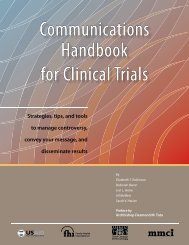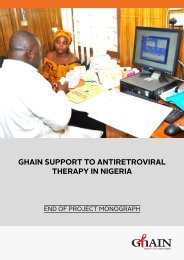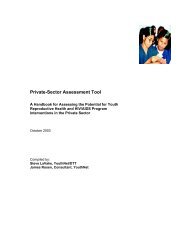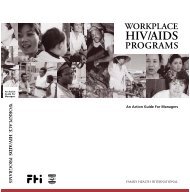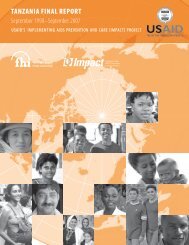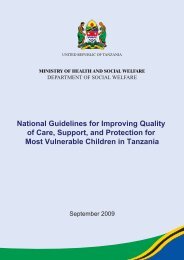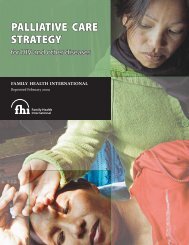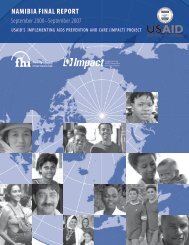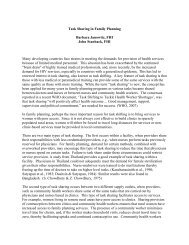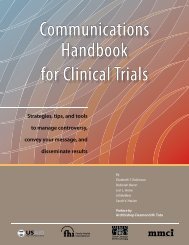2nd National Conference on Orphans and Other ... - FHI 360
2nd National Conference on Orphans and Other ... - FHI 360
2nd National Conference on Orphans and Other ... - FHI 360
You also want an ePaper? Increase the reach of your titles
YUMPU automatically turns print PDFs into web optimized ePapers that Google loves.
SLIDE 3: NUMBERS OF AIDS ORPHANS IN NAMIBIA<br />
(<strong>Orphans</strong> defined as children under 15 years who have lost their mother to AIDS)<br />
Commentary: The study projecti<strong>on</strong>s 180,000<br />
make obvious the fact that we are 160,000<br />
facing a big challenge in the coming 140,000<br />
years. They show that in 2002 we 120,000<br />
have around 20 000 AIDS orphans 100,000<br />
al<strong>on</strong>e. People may w<strong>on</strong>der why these<br />
80,000<br />
figures differ to those already given,<br />
<strong>and</strong> why they seem low. The answer<br />
is that we do not yet have a definiti<strong>on</strong><br />
of OVC, <strong>and</strong> these figures are based<br />
<strong>on</strong> the definiti<strong>on</strong> given <strong>on</strong> the slide.<br />
60,000<br />
40,000<br />
20,000<br />
0<br />
1995 1997 1999 2001 2003 2005 2007 2009 2011 2013<br />
Figures based <strong>on</strong> a definiti<strong>on</strong> including children up to 18 would thus be higher than these. Also,<br />
these figures pertain <strong>on</strong>ly to children orphaned by AIDS whereas others pertain to all orphans <strong>and</strong><br />
other vulnerable children. What is important is that the figures are rising. By 2010 we will have<br />
140 000 AIDS orphans, or more than 10 times the number we have in 2002. These projecti<strong>on</strong>s<br />
are therefore saying that we need to wake up if we have been sleeping.<br />
SLIDE 4: % OF CHILDREN WHO WILL BE ORPHANED BY AIDS BY AGE GROUP<br />
Commentary: The graph shows a 35%<br />
steady rise from 0% for all age groups 30%<br />
in 1995 to about 4% of all children in 25%<br />
the 0-4 group, 20% in the 5-9 group,<br />
±32% in the 10-14 group <strong>and</strong> ±13%<br />
in the 15-19 group in 2015. In 2002<br />
1-4% of children in each age group<br />
20%<br />
15%<br />
10%<br />
0-4<br />
'5-9<br />
'10-14<br />
15-19<br />
are AIDS orphans. Children in the 5-<br />
5%<br />
9 group are about to start school <strong>and</strong><br />
small as their numbers are today, we<br />
are already at pains to ensure them<br />
0%<br />
access. Children in the 10-14 group are moving into a new growth phase without parents, <strong>and</strong> we<br />
are not ready to address their plight. It is gratifying that we are planning our strategies now, while<br />
the proporti<strong>on</strong> of AIDS orphans in all age groups is still under 5%, so we will not be caught with our<br />
pants down, so to speak.<br />
1995 1995<br />
SLIDES 5-6: SUMMARY OF FINDINGS ON ORPHANED LEARNERS’ NEEDS<br />
1997 1997<br />
Learners’ needs have been divided into three categories:<br />
1. Ec<strong>on</strong>omic<br />
Fees/levies, uniforms, materials; food, clothing <strong>and</strong> housing; transport; employment; time.<br />
Hunger a comm<strong>on</strong> cause of dropout <strong>and</strong> poor performance – <strong>on</strong> the part of both teachers<br />
<strong>and</strong> learners.<br />
2. Parenting/family structure<br />
Cared for by elderly, siblings or extended family; child roles in care <strong>and</strong> households change;<br />
siblings are separated; <strong>and</strong> all these lead to early marriage <strong>and</strong> motherhood. Forty percent of<br />
teachers reported being aware of child-headed households, 39% of Grade 10 learners reported<br />
caregiving <strong>and</strong> other household activities to cause them to be absent from school.<br />
All these things have implicati<strong>on</strong>s for socialisati<strong>on</strong> <strong>and</strong> nurturing.<br />
42 <str<strong>on</strong>g>2nd</str<strong>on</strong>g> <str<strong>on</strong>g>Nati<strong>on</strong>al</str<strong>on</strong>g> <str<strong>on</strong>g>C<strong>on</strong>ference</str<strong>on</strong>g> <strong>on</strong> <strong>Orphans</strong> <strong>and</strong> <strong>Other</strong> Vulnerable Children – Windhoek, Namibia, 25-27 June 2002: Full Report<br />
1999 1999<br />
2001 2001<br />
2003 2003<br />
2005 2005<br />
2007 2007<br />
2009 2009<br />
2011 2011<br />
2013 2013



